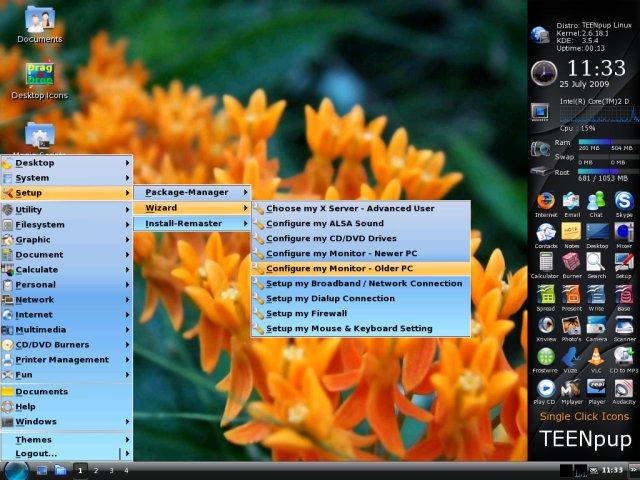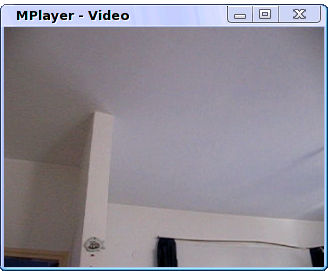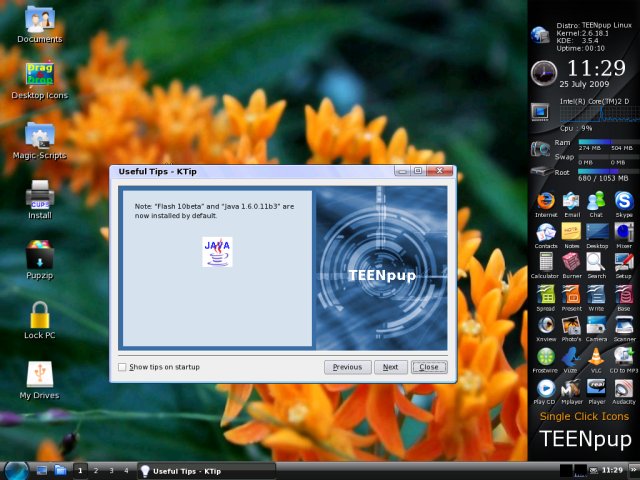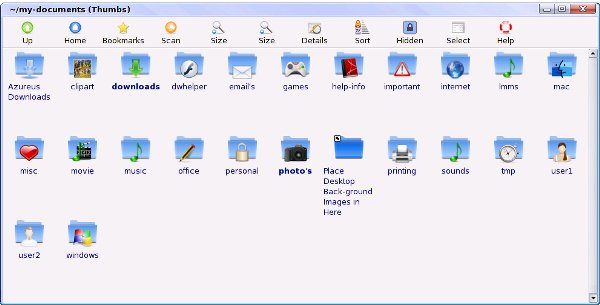Updated: September 16, 2009
You may have already figured this out - Puppy Linux is one of my favorite small size players in the distro field. It comes in many flavors, called puplets, as varied as the canine population. While they all have the same common ancestors, puplets are as different from one another as Chihuahua and Great Dane.
Indeed, while Puppy itself is around 90MB, some of its puplets are much bigger. For example, Macpup is twice as big. And today's candidate, a remastered Puppy called TEENpup is a whole 700MB, eight times the original Puppy and the same size as any other standard distro. It's like what Volkswagen Touareg is unto Polo, even though they both have four wheels. So, the big question is, is TEENpup as good as any standard distro?

Introduction
This question may seem misleading, as it may infer that Puppy is not a standard distro or perhaps does not meet the standards of a ... standard distro. The truth is, Puppy is a minimalistic, fast, lightweight live CD operating system. It's not meant to complete with distros like SUSE, Ubuntu or perhaps PCLinuxOS. What more, at under 100MB, a one-to-one comparison would hardly be fair.
Even so, even when you tackle Puppy head on against the big names, it's very impressive. It's a deadly punch of satisfaction. In fact, Puppy is probably the golden formula to how small distros should look like and behave.
TEENpup deviates from the modesty of its father and jumps into the big league. This review will show you whether TEENpup can handle such a leap. And besides, it's another review of another great puplet.
Booting TEENpup, an exercise in Xorg
For uneducated, Xorg may sound like something from a Star Trek movie, but it's the thing that makes you have a visual desktop in your Linux. In all my previous Puppy trials, I had no issue booting the distro with either XVesa or Xorg drivers, both resulting in good screen resolution and no visual glitches in the booted desktop.
TEENpup surprised me here. When I chose XVesa, I got a 16-bit Afghan of noise. Okay. I next tried Xorg and got a blank, black screen. TEENpup refused to boot into its promised, beautiful desktop.
I decided to try a few tricks on the command line during the boot, like adding a VGA parameter to the kernel options. I selected the 1024x768px resolution, which corresponds to VGA=792.

Puppy did not like this, complaining about an invalid value and offered instead a series of hexadecimal figures. I chose one randomly and let TEENpup boot. Eventually, this resulted in a hideous green menu where I could finally select a resolution for my monitor, as it was not automatically detected, despite being the most standard, banal monitor around.

Finally, a beautiful desktop
After this short ordeal, I was logged in. TEENpup desktop was phenomenal.

It mixes the classic Puppy elements, the somewhat simplified desktop icons, with Windows like elements, including the taskbar and the Applications menu icon, with a rather unique side panel on the right side, which contains quick-launch icons for the most popular programs installed. And judging from the colorful, exciting collection, there's quite a lot of those. The desktop wallpaper is also very pleasant. TEENpup desktop was very attractive. It was a good start. I could almost forget the Xorg shennanigans earlier. Now, it was time to test the basic functionality ... of everything.
Wireless
In this regard, TEENpup is no better or worse than standard Pup, although it comes with the network connection activated, which is a blessing for less knowledgeable users and has always been sort of a geeky, pedantic nuisance. TEENpup auto-connected to an unecrypted network in the range, but it would not connect to my WPA2-encrypted routers, as it wrongly classified them as WEP, which is exactly what happened with the default Puppy.

This aspect is a bit disappointing, as one would expect the extra 600+ MB to be also invested in improving hardware detection and adding more drivers. One more thing that is noticeable from the screenshot above is the rather Vista-like theme. It's up to you to decide whether you like it or not. Personally, I'm not very fond of this choice.
Bluetooth
No drivers were available. Sorry.
Setting up the desktop
Another thing you may want to do is tweak the distro this and that way. Again, trying to do anything with the monitor settings turned into a fiasco. The only way TEENpup would play ball was by choosing weird hexadecimal values when booting and then letting it be.

Overall, TEENpup tries to be quite helpful. In fact, the menu is arranged in a logical, intuitive fashion and offers lots of useful tips to new users. For instance, you don't need to mess with the X server by straining your fingers across the keyboard, there's a menu entry for that. Or if you're wondering about your USB devices, you have menu entries phrased as questions, just as a casual user might ask them.


Drive Mounter
This is another useful thing, a utility that allows you to mount/unmount your devices. TEENpup had no issues detecting and using either FAT32- or NTFS-formatted Micro Cruzers, although U3 filesystem has long been annihilated.

Multimedia
This was another important test. I'm glad to say there were no problems. TEENpup played everything without any issues: Flash, Windows video, MP3. I forgot to take a screenshot of Youtube, I hope you'll forgive and trust me.


Applications
Another thing that TEENpup does not lack is the extremely rich and varied repertoire of excellent applications. All the popular titles are there: VLC, Vuze, Skype, MPlayer, K3B, Pidgin, OpenOffice, and many others. Many of the applications used in TEENpup come from the KDE desktop. Overall, the visual integration is quite good. Here's a pair of juicy screenshots:


What do we have here? Well, in the second screenshot, we have an OpenOffice Impress presentation. In the first, a lovely collection of multimedia and networking apps, including Skype, RealPlayer, VLC, and MPlayer. You also get one of the best CD/DVD burning programs available, K3b:

And a few other exotic programs, like Cycas for 2D/3D architecture drawing, CAD-style, KMyMoney for home finance and Draw SWF for creating Flash animations:



And let's not forget SeaMonkey:

Java
It's also fair to mention that Java is also installed. You may notice this from one of the many startup tips shown when you boot into the desktop.

Magic scripts
Magic scripts are the golden asset of this distro. I have not seen them anywhere, but they seem incredible. A seemingly innocent collection of icons, the magic scripts are active icons onto which you can drag 'n' drop actual multimedia files. And depending on the icon, the multimedia files will be processed - converted. Incredible!

Here's a demonstration. I dragged my Shock The Monkey MP3 file onto an audio converter. I am then asked to choose the output format.

And the conversion will start:

And there you have a converted file (in OGG format) playing:

Absolutely fantastic! You're encouraged to read about the scripts and learn more about how to use them, although the basic functionality is dead simple.

Good looks
Indeed, TEENpup is quite pleasing to the eye. It has a good selection of visual tricks, while still maintain its lean and mean Puppy nature. Everything runs fast and smooth, despite the eye-pleasing decorations, which do not take away precious system resources.
For example, here's the "my documents" directory. Quite appealing. In addition to a well styled application sidebar and sexy wallpapers, TEENpup manages a rather stylish and beautiful facade.

Conclusion
TEENpup is a rather interesting concept. It's Puppy through and through, with some embellishments of its own. The speed, the responsiveness, the multi-purpose variety of programs and utilities, and the great functionality of most everything is the typical Puppy legacy. On top of these, TEENpup brings an assortment of first-class programs, great looks and the fabulous Magic scripts.
On the downside, the setup of the X server, the graphical frontend of the distro and the Wireless networking were somewhat of a disappointment. I hope these issues will be ironed in the next release, even if this means letting some apps go in favor of more and better drivers.
Still, as a live CD that will run well on older machines without fancy graphic cards, a live CD rich with codecs and good programs and great speed, TEENpup is a pleasant surprise, a player in the big league.
As it does not aim to be installed, even though it can, TEENpup may not exactly replace Ubuntu or openSUSE as the favorite desktop distros in every household, but as a live CD Linux that you can safely and with great pleasure use anywhere, TEENpup is definitely one of the smarter choices you can make.
700MB is a lot, but if you can forgive that, then you have a big, fluffy Puppy that should serve you well. Another must-have in the exciting, growing live CD collection, another excellent puplet.
Cheers.